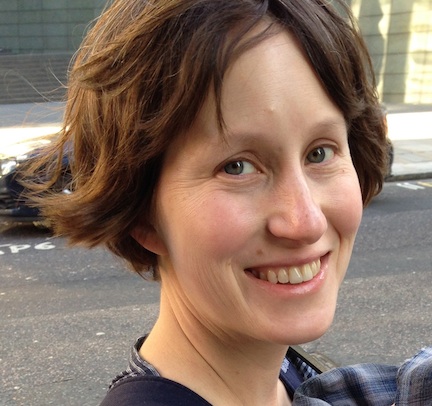Walking, Drawing, Indexing: Representing Bodily Experience of Landscape
by Aileen Harvey
published November 2014
Introduction
The human experience of landscape is an experience of a body in motion in an environment that doesn’t stand still. In contemporary landscape art, this doubly mutable relationship of person to place is often made evident. Drawing and walking are usefully enlisted to highlight that mutability. Both activities are apt for emphasising motion: that of the artist who draws or walks, and of the object observed—the landscape environment—which can be seen to shift and alter.
This inherent capacity of walking and drawing to emphasise movement is activated by how the walker or draftsperson visualises and communicates experience. Walking is immersive. It undoes the static, singular viewpoint upon a landscape; rather, the walker's experience emphasises the embodied and temporal aspects of perceiving. Within a visual art practice, walking lends itself to representing a human subject embedded in the world and knowledge that is located and emerging over time. A natural ally for this way of thinking about experience is the phenomenological view of Maurice Merleau-Ponty; in The World of Perception he describes a subject as “a being who can only get to the truth of things because its body is, as it were, embedded in those things” (43). Moving through a landscape, the body inscribes a path, traces an evolving line. The body also gathers to itself the residues (both material and experiential) of the places passed through. These parallel traces of the walk can be used to communicate that walk; the line and residues can both be seen as the indices, or direct imprints of person and place.
The processes of drawing too are inherently physical, whether those processes involve the delicate coordination of hand and eye, or large gestures that employ the whole body. In making a drawing, an artist can use the active qualities of mark-making to convey movement and change over time, both the movements of the artist and of that which is represented within the drawing. A drawing can, for example, embody a set of careful, spatio-temporally specific observations, revealing differences in a landscape arising across time or through shifts in perspective. Thus, like walking, the act of drawing can be used by an artist to reinforce the embodied and temporal nature of human experiences of landscapes. Furthermore, the resulting artwork can include the index of a landscape, its direct marks or material remnants.
Such indexical recordings of a landscape experience are importantly direct and singular: they happen at a certain time and in a certain location. In relating a human body's trajectory to an environment, they can be read as cartographical. If an artwork could be used to recapitulate a pathway through the world, it is in some sense a map. Works that represent indexically can also function as narratives, as recounted sequences of events. It is possible, furthermore, to contrast the representational regime of the index with that of the picture. The distinction at work is between visual evidence and naturalistic images (images of all kinds, from photographs to drawings to oil paintings). A pictorial approach to landscape art need not—but in practice often does—result in the fixed and detached viewpoint of scenic landscape painting in the Western tradition, a tradition often criticised for its ideological conservatism, for instance by Denis Cosgrove’s influential argument in Social Formation and Symbolic Landscape that landscape as cultural expression shores up social hierarchies (22-32).
This paper seeks to understand how six contemporary artists render their experiences of landscape into compelling artworks: Irene Kopelman, Roni Horn, Gabriel Orozco, Francis Alÿs, Richard Long, and Helen Mirra. The artworks discussed indicate some ways to move away from the primarily pictorial in visual art, variously combining walking, drawing, and indexing to draw out the interdependence and the temporality of person and place.
1. Irene Kopelman
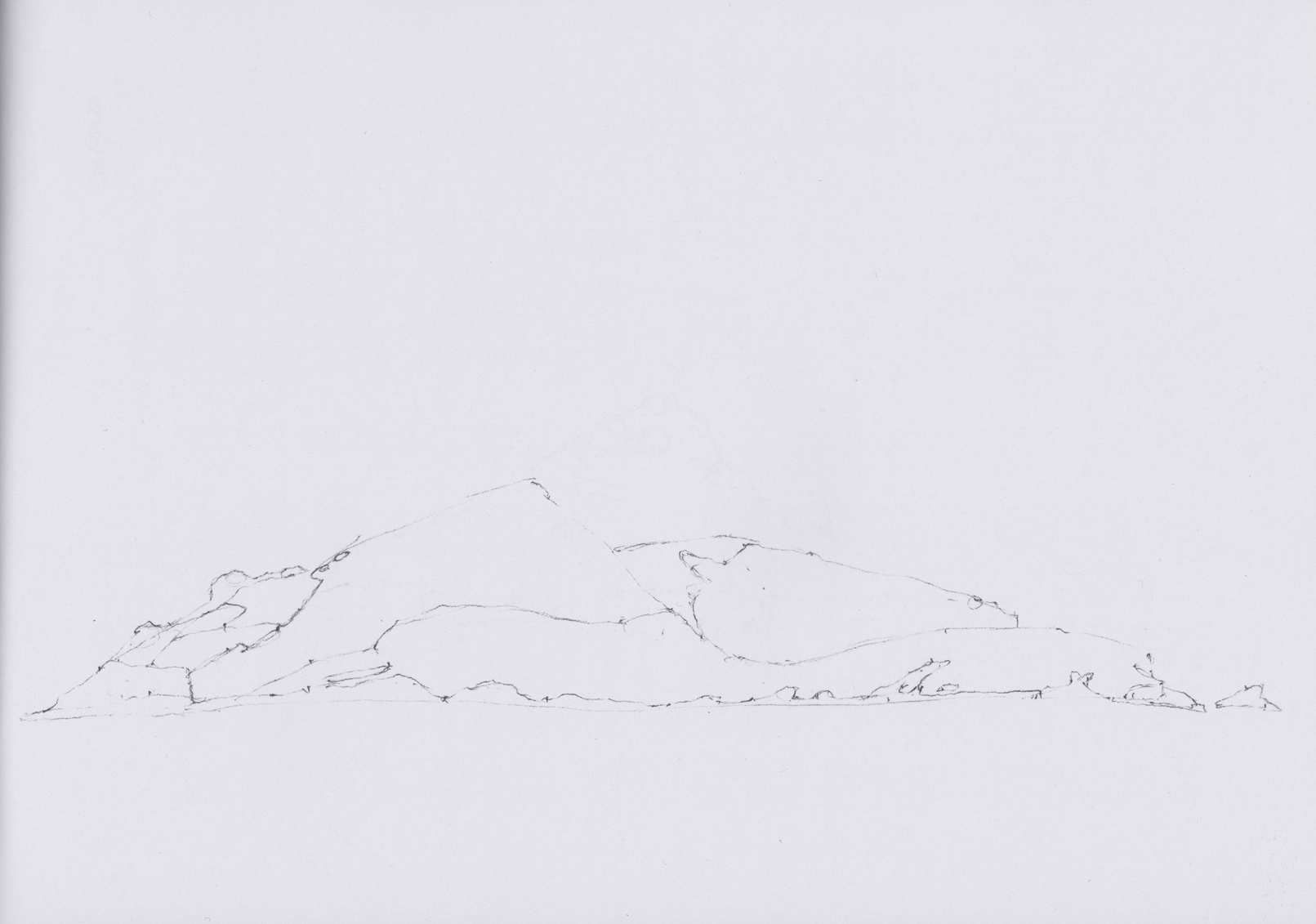
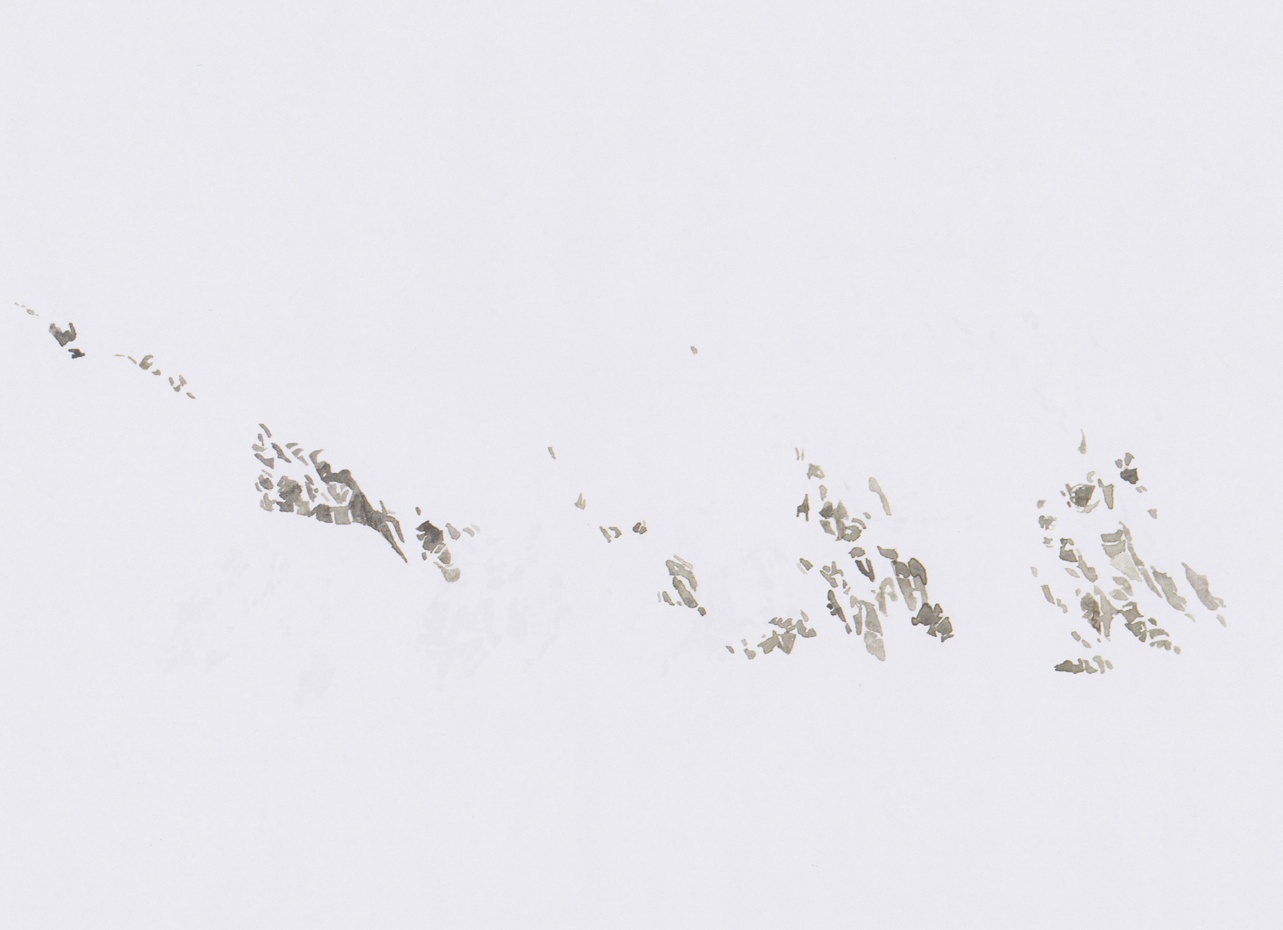
Displacement, time, and bodily location are built into the work of Argentinian artist Irene Kopelman. A series of drawings made during her journey to the Antarctic in January 2010 and published as an artist's book, 50 Metres Distance or More: Notes on Representation Vol. 4, provide an example of how even a naturalistic picture can trace motion through its non-pictorial aspects. Despite their sparseness, these are realistic depictions of the landscape: we see the delicate outlines of isolated mountains and icebergs. In the watercolours, the empty white paper reads as cloud, veiling peaks. But the pictorial content of each drawing is very thin, and their wavering, incomplete lines tell the viewer about the context in which they were made—on a moving boat, in the cold and wind, and during breaks in the snowfall—as much as they serve to describe the curve of a slope. In the drawings’ look of provisionality, the quality of the marks, a viewer can read the interruptions and restrictions that were part of the circumstances of their making.
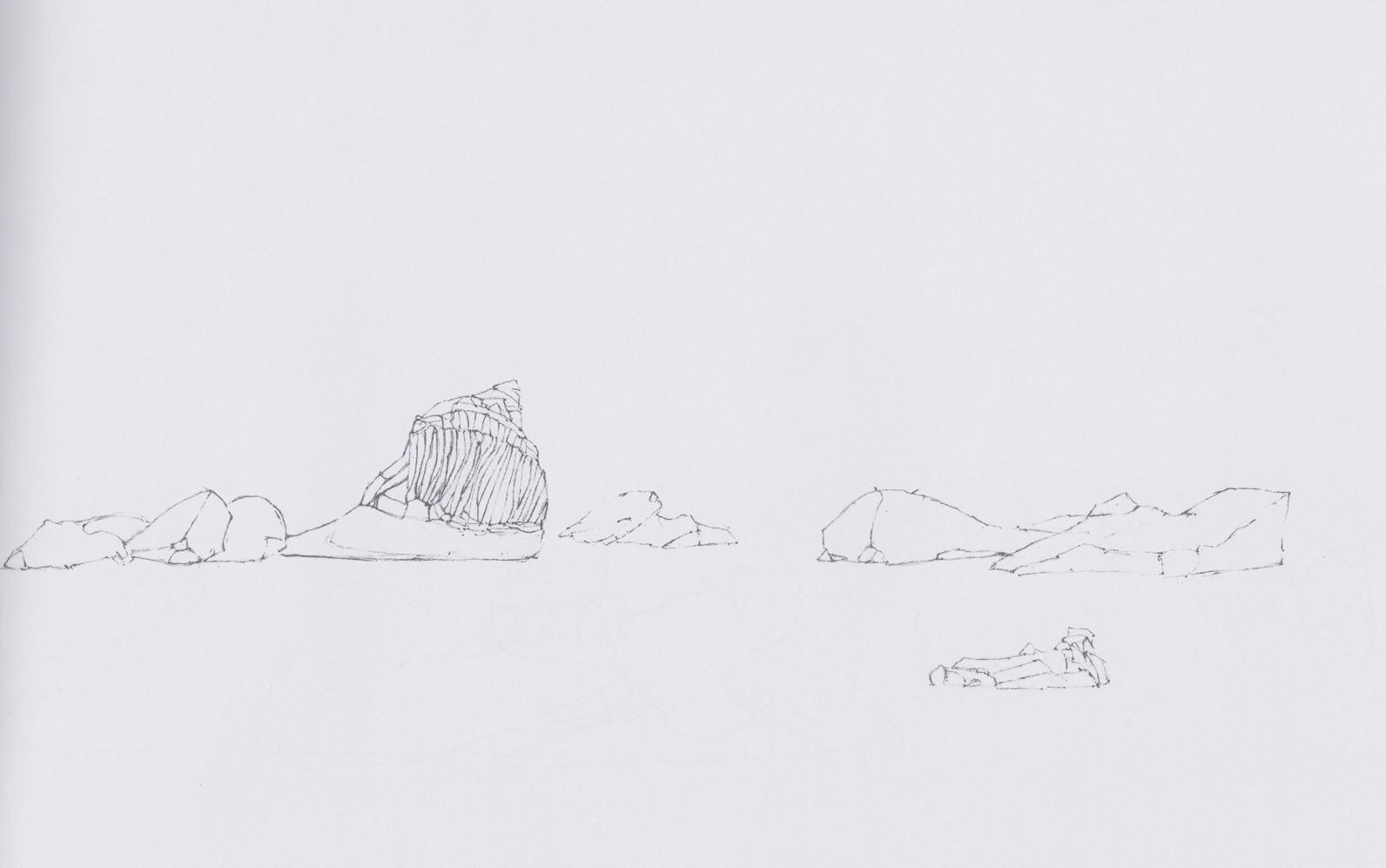
In what is there, because it is so sparely but laboriously recorded, it is possible to trace the movement of Kopelman's eye and hand, the minute scanning of these gigantic forms. In 50 Metres Distance or More, she says that “Surveying the mountain with your eyes is already a way of drawing” (pages not numbered). I’m reminded of how a climber views a mountain, such that the eyes project the body onto the distant surface in a kind of rehearsal. Or, there is a parallel with map-reading, with the mind bringing a dotted path on paper into alignment with the track underfoot (which can lead some people to turn their map upside-down).
Kopelman’s urgent and intense attention to the landscape remains apparent in the drawings—in the journey of her eye, as well as the slight hesitation of her hand. These signs are indices of her physical and emotional presence, at a particular time, passing through that landscape. As well as allowing the viewer to re-trace her spatio-temporal presence, they give these drawings temporal extension; they make them part of a series of events. Within the artist’s book the narrative aspect of the drawings is further drawn out by their presentation as a chronological sequence, interspersed with Kopelman’s diary entries from the voyage.
2. Roni Horn
Roni Horn's pigment drawings are made in her studio. However, travel is implicit in them, in the sense of visiting a landscape and experiencing it intensely. In Horn’s case, this landscape is always Iceland. In her later, large-scale works, her characteristic process of intercutting and re-forming results in narrative maps—which tell the viewer about the accrued movements of hand, arm, and body, that shifted the sections into place. These abstract drawings are not naturalistic images of landscape; instead, they evoke time, alteration and contingency, both in bodily experience and in landscapes.
The pigment, mixed with turpentine, is applied in layers and then varnished. The blotchy, vibrant forms, which hover on a smudged white background, have been cut, shifted and combined to arrive at a final drawing. These forms resist straightforward description; even the simplest are only roughly oblong, or somewhat curved. They become progressively more characterful: toothy and fractured, the later ones scattered and refracted. Dieter Schwartz notes that they are more like “deposits” than representations, “more formations than forms (114). They don’t refer to seen or imagined objects; instead they show that they have arrived here by a material process. There is an in-betweenness to the colours: what Briony Fer describes as chromatic slippage. To the titles too, which are connective words like “Must,” “As,” and “The” (9-10). This gives a feeling of elision, of unfixed identity.
This sense of flux also applies to the ground, which is riven with cuts and smeared with colour. It is, as Fer points out, “as material as the shapes” (8). Form and ground both shift about, particularly in their placement. In Horn’s practice, as Schwartz notes, place occurs most often as a verb; To Place (the title of a series of books by Horn), links to the positioning of a subject, proposing self and place as in a reciprocal process of becoming (113).
These drawings allude formally to landscapes. The shifted sections of paper evoke geological movements (Roni Horn calls them plates). And the pigment forms can suggest, if only loosely, elements of an active landscape: volcanic extrusions, glacially deposited boulders, lava flows. But it is most of all in their method of construction, which remains plain in the finished drawings, that they suggest the land in motion. In later drawings, the cuts and displacements are more elaborate and prominent, annotated with registration marks and words. On each drawing there emerges a record of the progression of the drawing process, a map of the route taken through it by Horn—although one that is too complicated and ambiguous for viewers to follow.
The final state of a drawing conveys movements and changes that have been halted. Looking at that suspended process, we can feel “he open scale of the parameters” (Schwartz 117). Horn’s decision to stop the drawing here, and the possibility of further change, are both palpable in the finished surface. She has written that the progression of the drawings is “a kind of path created in a place without visible landmarks” (letter to Briony Fer, qtd in Fer 13). The map of them, then, is an inscription of something open-ended and improvised; it is the inverse of a map used for journey-planning.
Horn’s recent drawings are very large, well over two metres across. They involve the viewer’s body, as most of the small early ones did not, in a process of navigating across the marks on its surface. It is almost impossible to take the form in all at once, as a simultaneously-given picture. It is easy, on the other hand, to get lost. Alongside this bodily impact, there is the heightened temporality of the viewing experience. We engage with it as a narrative as we gather a sense of the drawing, following lines that have been laid down by its construction, so that the time of making is overlaid with the time of viewing. A network of accumulated traces left by Horn's movements, it is both map and story.
This presence of a drawing's history on its surface points directly back to something Horn has said about the young geography of Iceland: “One reads the history of this place as directly as present circumstance” (To Place, endnote). Further, these fractures and instabilities in the drawing generate an idea of place as having an identity which, far from being fixed, is contingent, accumulated, and constructed over time from the continually altering relationship of viewer to view.
3. Gabrial Orozco
“Yielding Stone,” a sculpture by Gabriel Orozco, is a ball of plasticine, equal in mass to Orozco’s own bodyweight. The ball is rolled through the streets of a city, gathering dirt and debris. What we have, then, is a sculpture that memorialises an urban walk, through incidental markings and residues. Sitting on a gallery floor, it is a heavy, quiet thing that remembers movement in its shape and texture. Within this work, the walk functions to connect body and place, generating the relative motion recorded by the sculptural object. Thanks to this method of creating it, the sculpture is an object which emulsifies location and experience together into an inextricable whole.
“Yielding Stone” is a print or index of a portion of the city, and it maps a route through it, but it also records a period of time, and of awkward exertion. Both map and history, it is a condensed narrative of Orozco's slow progress through this particular city, a narrative that conveys itself physically, through the sculpture's relationship to the viewer's body. Alex Potts, basing his thoughts on Merleau-Ponty’s phenomenology, reminds us that seeing has bodily dimensions: it incorporates and is integrated into our senses of movement and touch (214). Orozco's uneven ball of dirty plasticine should not be perceptually separated from a sensation of effort, of pushing and travelling.
The sculpture's surface blends time and place, and the whole object remains insistently in time, by continuing to accept new matter from its surroundings. It faces into a future where dust and fingerprints may begin to obscure the traces of past action. It is a reminder, like Roni Horn's drawings, that place is related to time. And, the sculpture's own porous boundaries, its own identity, is something that shifts and emerges.
“Yielding Stone” is a tactile object; the tacky grittiness of its surface is something that the viewer experiences haptically, that is, as an experience of touching it. For Mark Paterson, our haptic understanding of objects and space arises from both tactile information and body memories (115-31). “Yielding Stone” activates haptic space for the viewer. It is also unmonumental, humble. It is an art object without gravitas or permanence, made from a provisional material. Perhaps most significantly, this sculpture mirrors a human body’s weight. When I sense its mass, it is also my own. Its vulnerability is human too. Not only an index of the city, but a double for the artist, who stands in this case for an ordinary human subject, yielding to events.
4. Francis Alÿs

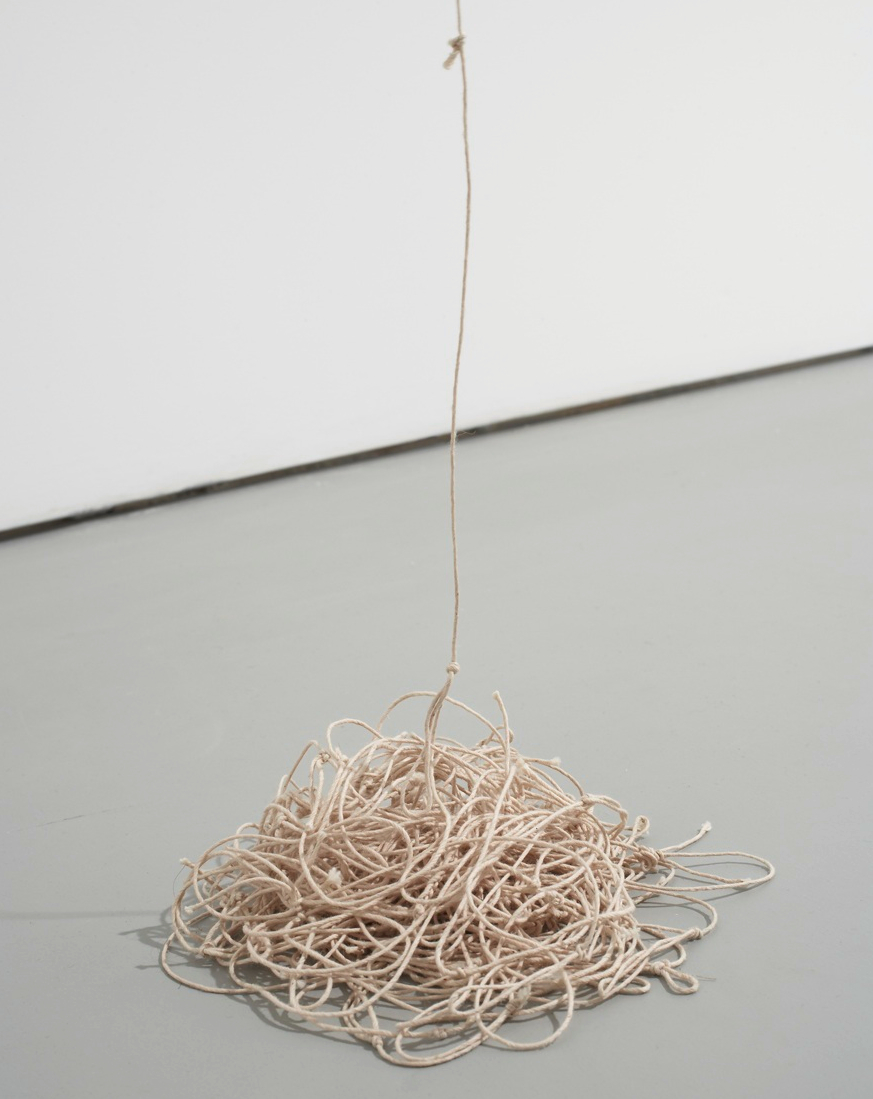
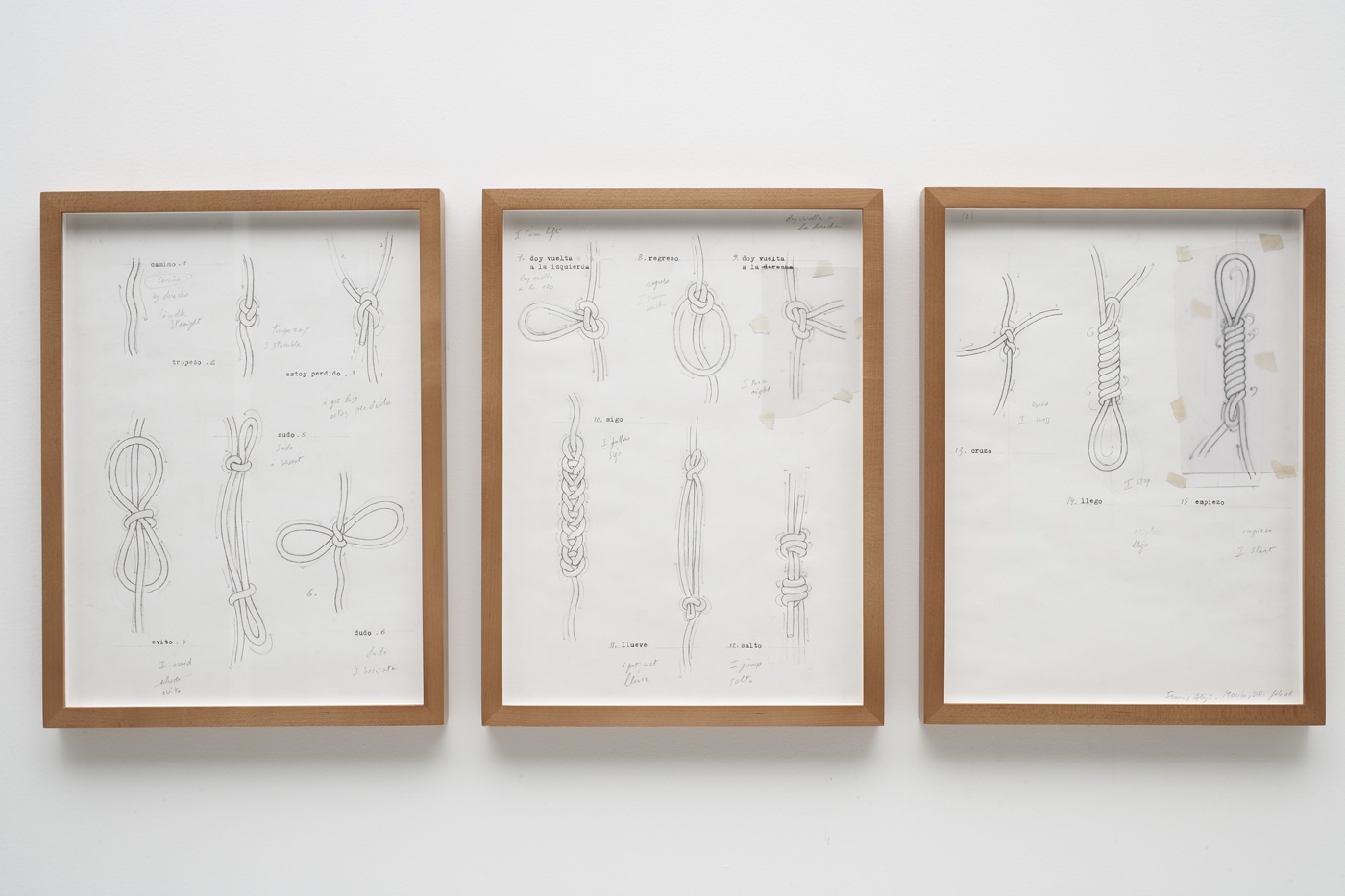
Fig 6: Francis Alÿs, from “Knots,” 2005. Courtesy of the Artangel Collection at Tate.
Francis Alÿs gives us a second example of a sculpture that records a walking experience. It’s a piece of ordinary string several metres long, knotted at intervals. The knots are a code for registering the incidents of a walk: the walker's movements and reactions. The work, “Knots,” also includes drawings, which decode the vocabulary of knots. So, for example, the Alpine Butterfly knot means “I turn left,” and the Figure Eight “I stumble.” Like “Yielding Stone,” “Knots” stands in territory where maps and narratives overlap: the creation of physical objects that register a body's passage on foot through a landscape. In Orozco's piece, the record is an imprint, a direct trace of the walk; in Alÿs’s, the reference to movement is made through signs of his own invention, signs built into an object that could then be used to tell a story, or to navigate a path.
Alÿs’s walk results in a mnemonic, which can be read by touch, running the string through the fingers. It resembles several traditional methods for recording a sequence of events, especially the Palingawi knotted cord, which, as Tim Ingold describes in Lines, is used by a tribe in Papua New Guinea for ceremonial retellings of their migration legend (66). Both cords are a physical encoding of a journey narrative; they foreground touch and movement in its reception. As with Orozco's plasticine stone, too, our relationship to Alÿs’s knots is one of half-knowing, half-wondering what the knots feel like. Plasticine and string both propose tactile-visual methods of representing the experiences of a body in motion, methods of communication which bring the viewer’s body, as well as the artist’s, into prominence.
The knotted string is also a proto-linguistic object with social dimensions. This aspect of his artwork enables Alÿs to examine a shared language (in this case, sculpture) for passing on individual experience, highlighting both physicality and codification as part of the workings of sculpture as a language.
5. Richard Long
Richard Long has made a wide range of text pieces over the course of his long career of walking. He has said that these works are narratives, but read as narratives they are fearsomely sparse. The way that some of them work is as poetry. As Elizabeth Helsinger has emphasised, much landscape poetry is not simply descriptive. In fact, she writes in “Blindness and Insight,” “the detail of poetic landscapes is often minimal, radically selective, and rhetorical” (326). This is particularly true here. Helsinger's point about poetry provides a parallel to my line of argument that much landscape visual art is not simply depictive.
A text work from 1979, “Pico de Orizaba,” lists the material qualities of the landscape underfoot over a five-and-a-half-day walk. It is a particularly strong example of his use of poetics to evoke walked landscapes. With great economy, the text appeals to multiple senses. The listed items—“snow, warm gravel,” or “pine needles, powder dust, grit” (Long, pages not numbered)—have tactile, aural and olfactory impact; they bring with them the temperature of the air, the crunch of the path. Not only do the listed phenomena convey sounds, textures and smells, they also carry the entanglement of the senses—such as the way that the scent and taste of fine dust are inextricable and are bound up with the feel of it underfoot. The text reminds the reader that walking generates this enlivening of the senses.
Long uses language here to evoke not images, but sensations. In isolation, these single or paired words can’t represent an event or even a glimpsed view. Instead, each line hands the reader a brief sensory flash, readily identified as the experience of a walking body. The result is to remove distance and perspective, to immerse the reader in the landscape, not in an observer's role. He reminds us of the imperative connection between ground and foot.
He makes use of rhythm, repetition like footfalls. That rhythm inserts motion, time and the body into the work. It too contributes to the elimination of the static viewpoint, the illusion of detachment. The list format locates the phenomena in a very specific temporal sequence—the bare bones of a narrative—while also abstracting them, enabling them to refer outwards, to the experiences of others. These sequences work too as sensory maps, inscribing a line of experiences, and also as material maps, which in principle could allow a reconstruction of his route (just as a forensic examination of the dust on his shoes might allow).
By contrast, in some other works (for example, “A Walk in a Green Forest,” 1997), this groundedness in the body can be overwhelmed by more lyrical imagery, such as “Magnolia trees like patches of snow.” The continued presence of other senses, and the pacing of the list, are key to balancing what could otherwise be a series of beautiful vignettes, which hold the viewer at a scenic distance.
Long’s texts are landscape works in which the figure is never shown directly. Instead, we have an embodied consciousness filled by the landscape. In 1984 Long described his work as “a combination of the natural energy and the abstract idea” (Stewart 9). The text delineates the project: the where, when, how far, for how long—such texts often include circumstantial instructions concerning the weather, moon-phase, or what is encountered while walking, allowing an active space in the work for natural processes and events. On the other hand, they tend to follow straight lines or circles, simple geometric figures mapped onto the earth with his body. This transposition of abstract forms onto real topography engages the viewer in a pared-down version of cartographic thinking, eliciting reflection on that mode of thought. His walks are often said to be like drawings on the earth, but most are drawings of which the overall shape cannot be seen, only walked. These lines of gigantic length and duration invoke both a heroic corporeality and a superhuman scale: a self measured against the earth in walking, as well as the earth thus paced out.
6. Helen Mirra
The American artist Helen Mirra also generates artworks through long programmes of walking. The 2010 series “gehend (Field Recordings 1-3)”relates to three months hiking in three different regions of Europe: around Zürich, Bonn and Berlin. On the days when she walked, she made seven prints by a structured method: stopping each hour, selecting an object found along the path (a stump, a weed, a branch), and taking an ink imprint onto linen. The prints were later sewn together into sequences, forming a fragmented timeline for her presence in the landscape.
The process generates images that, like Irene Kopelman’s drawings, attest to the circumstances in which they were made. They also, like Orozco's sculpture, directly index a journey. They are indexical abstractions, the physical trace of the landscape. In “Dialogue, April-June 2011,” Mirra writes to Peter Eleey that “direct prints are facts without too much information, dependent on physical contact” (14).
These works of Mirra’s are very reticent. The printing method results in incomplete representations: mirror images, cropped, where detail is lost and ink bleeds. Are they botanical samples or calligraphy? The shortage of information allows for contradictions. That same ambiguousness runs right through her method. Although the process for recording the landscape is rule-governed, Mirra underlines its subjective gaps, as Christina Vegh notes in “Walking and Bending” (4-8). Her system for measuring walks is not only relative to her body, it also varies by region, being given in hours for Zurich, kilometres for Bonn, and steps for Berlin. Her walking then generates maps that are inextricable from her body's capacities. Further, these diverse versions of her set of rules suggest the cultural content of scientific information, and by extension also that nature and culture are inseparable in the production of the landscapes themselves.
Neither the sensory qualities of the locale, nor her individual experience as she walked, can be seen in the prints. Nor can the walks be extrapolated or retraced; they have a kind of scale, in the regular hourly intervals, but the printing has both aestheticised them and made them too ambiguous, somehow too generalised to provide a story or a usable map. The landscape remains in the work only in the order of encounter with its small features. These form an index, which, as Peter Eleey writes in an article for frieze, “implicate[s] everything left unnoted” (149). Just as a book index points to–and structurally maps out–the whole text, but does not summarise it or convey any of its tone, these prints remain resolutely quiet about the walk, the spatio-temporal bodily event that made them. They are the traces of the landscape, but do not allow a viewer to work back to it. However, with these works Mirra communicates the agency of landscape. The prints align themselves with the landscape's causal processes, by having the look of self-generated imprints: fossils, or the kind of stain that dead leaves deposit on the pavement.
The body in motion remains only in the gaps of distance and time between the prints, and in the creases the linen has kept from a day in a backpack. The body is implied in the metre of the prints’ repetition, like the pauses that punctuate a day’s walking. This rhythm of physical movement is reinforced by the viewing experience, which asks the viewer to walk alongside the work. The structure of narrated events is there; however, the prints do not concatenate into an individual narrative.
Each of these six artists has an approach to art-making that gives a prominent role to the body in motion, whether that motion is sketching, cutting and rearranging, strolling or hiking. Walking and drawing, used by these artists in various ways, enable the resulting artworks to function as reminders of those movements: as indices rather than simply as naturalistic images. Seeing these artworks as indexical makes it possible for viewers to align the artworks with cartographic and narrative modes of representation. Viewing the works in this way enlarges their resonance and also, as a step away from the purely pictorial, questions the idea that both viewer and landscape are static. Through these artistic approaches to communicating the experience of landscape, viewers are reminded, often via the enlisting of their own bodies, that both subjectivity and landscapes are active, flexible, and constructed.
Works Cited
Cosgrove, Denis. “Introduction to Social Formation and Symbolic Landscape.” Landscape Theory. New York: Routledge, 2008. 17-42. Print.
Eleey, Peter. “Reference Material.” frieze November 2006: 146-149. Print.
Eleey, Peter and Mirra, Helen. “Dialogue, April-June 2011.” Helen Mirra: gehend (Field Recordings 1-3). Bonn: Bonner Kunstverein, Berlin: KW Institute for Contemporary Art, and Zurich: Museum Haus Konstruktiv, 2011. 10-19. Print.
Fer, Briony. “The Pigment Drawings.” Roni Horn: 153 Drawings. Zürich: JRP Ringier, 2013. 7-14. Print.
Helsinger, Elizabeth. “Blindness and Insights.” Landscape Theory. New York: Routledge, 2008. 323-342. Print.
Horn, Roni. To Place: Lava. Denver, CO: Ginny Williams, 1992. Print.
Ingold, Tim. Lines. London: Routledge, 2007. Print.
Kopelman, Irene. 50 Metres Distance or More: Notes on Representation Vol. 4. Amsterdam: Roma, 2011. Print.
Lippit, Yukio. “Ambulations.” Helen Mirra: gehend (Field Recordings 1-3), 2011. 20-29. Print.
Long, Richard. Richard Long: Selected Walks 1979-1996. Edinburgh: Morning Star Publications and Dundee: Centre for Artist Books, 1999. Print.
Merleau-Ponty, Maurice. The World of Perception. Trans. Oliver Davis. London: Routledge, 2004. Print.
Paterson, Mark. “The Forgetting of Touch: Remembering geometry with eyes and hands.” in Angelaki 10 (3), 2005, 115-31. Print.
Potts, Alex. The Sculptural Imagination. New Haven: Yale UP, 2000. Print.
Schwarz, Dieter. “Just, Doubles, This, The, Distant Doubles, Must, As & others.” Rare Spellings: selected drawings 1985-1992. Düsseldorf: Richter Verlag, 1993. 113-118. Print.
Stewart, Nick. “Richard Long: Lines of Thought: A Conversation with Nick Stewart.” Circa 19 (November-December 1984): 9. Print.
Végh, Christina. “Walking and Bending.” Helen Mirra: gehend (Field Recordings 1-3), 2011. 4-9. Print.
Images Cited:
Alÿs, Francis. “Knots.” 2005. Courtesy of the Artangel Collection at Tate. (Figs 4-6)
Kopelman, Irene. “Untitled,” from the artist’s book 50 Metres Distance or More. 2011. Courtesy of the artist. (Figs 1-3)

